![]()
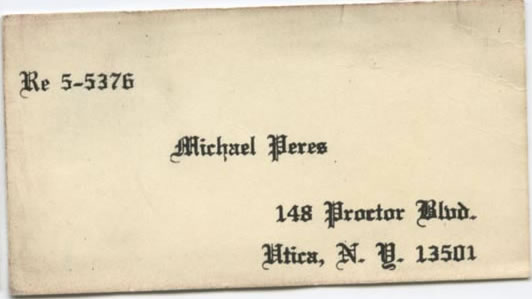 |
My 1974 Business Card |
My Story In June of 2003, I was invited by Dr. Lennart Moller of Stockholm, Sweden to participate in a book entitled Images in Science pictured on the right. It was the first time in my 30+ year career that I had been invited to share my career story and photography. I am not sure whether this was the catalyst or if there were other reasons but I became interested in sharing my career story on my web site. I have been frequently asked how I got into this field – sometimes by prospective students – and the following is my story. |
 |
At this point in my life, I cannot imagine doing anything else. I learned early on, that there would be no guarantees and that I could create my own opportunities through hard work. By giving freely of myself I have been the direct beneficiary of so any rewards. The former principal of my children's elementary school once gave me a plaque that still has great meaning. The message on the plaque shares "The more you give, the more you will receive". This philosophy has been a guiding principle in my life. I learned at a young age by watching my parents how were big on volunteering how important giving freely was. NETWORKING has also been an equally important tool. Not being shy, I have often meet new people in unexpected places. I have found many of my collaborators along a pathway that often I was not seeking. Sometimes I wanted something that did not happen but when one door closed, a new one opened. I also learned that opportunities may only come once and that you must
be prepared to act on them or be left wishing you had. I have found there rarely are second chances. To that end, I have taken full advantage of every chance not knowing where the opportunity might lead or who I might meet along the way. I have also - like so many - experienced rejection and adversity along this path. Nothing has been easy but it has been very exciting. I also challenge myself and live frequently outside of my comfortable zone. Without new experiences to shape new thinking, nothing can change |
 |
I attended John F. Hughes Elementary School and I remember a few grammar school teachers. Mrs. Carmella Catera is one that I recall with fondness. I was in her Introductory Physical Science class - a sort of accelerated class at the time - where I learned about titration, distillation as well as environmental awareness. She was way ahead of her time in the earth movement and she made her students aware of man’s influences on the environment. Good teachers, as I look back really influenced me. I can remember the joy of being challenged to learn and develop attitudes about life right from the beginning. Education was a core family value. Education was a vital in ingredient for success and there were no short cuts to being successful. Hard work and perseverance were characteristics of successful people My grandfather went to Harvard, was a NJ state beach volleyball champ. He was a dentist. My grandmother
was from a respected and educated family and all of my uncles and relatives on both sides of the family were either physicians, lawyers or successful in business. My dad also loved sports,
which rubbed off on me at a young age. While I played little league baseball
and I also made the John F Hughes school baseball team, it was apparent early on that I would not be a professional athlete :). My minor league baseball team went 1-18. I also played in several “rec”
basketball, bowling, and golf leagues. I was always doing something
that involved athletics. While not very good, I loved the challenge and competition during that phase of my life. |
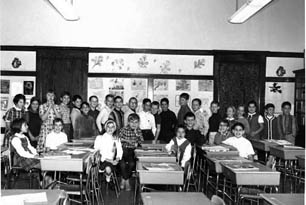 |
|
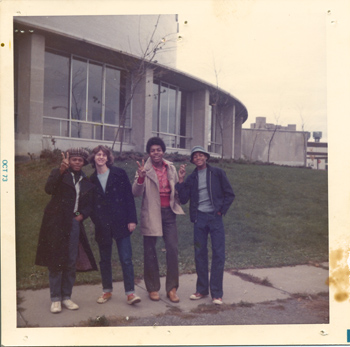 1972 looked like this. |
 |
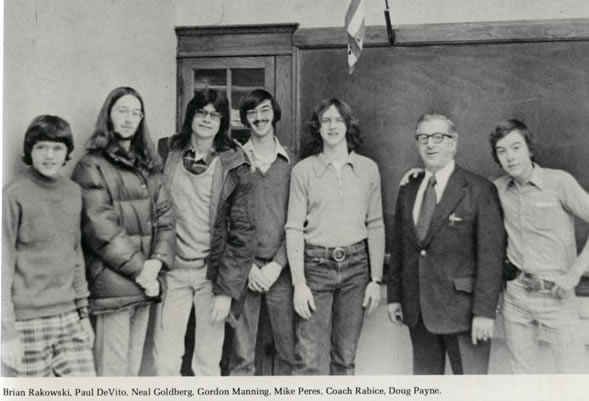 |
By some strange destiny - while at the Jamboree at the foot of Mt Fuji in 1972
amongst the thousands of Scout troops from all over the world - Japan was hit
by a typhoon. The storm wiped out all the camps and all scouts were evacuated
to various safe places until the storm subsided. I ended up in a Shinto shrine with hundreds of campers
from other countries including the Nigerian scouts. It was here that I first
met Prosper Igboeli, who at that time was a Scout from the East Central State
of Nigeria, formerly the Biafran Republic. Prosper and I became immediate friends
and he shared his dream to come to the U.S. and become a doctor. He
desperately wanted to become a physician so he could return to Nigeria and open
a hospital dedicated to his parents Margaret and Moses. His father - Moses - was a general
in the Biafran army during the revolution and fought for independence from Nigeria.
When the war was lost, he was executed which profoundly affected Prosper and
motivated him in ways I could not always comprehend. |
Upon returning, I was excited to tell my family about Prosper and I could barely control myself. As a consequence of much hard work and generosity from my family, Utica College, the Utica Kiwanis club and many others, Prosper was admitted to Utica College in spring 1973. Prosper immediately became a member of my family and his influences on me were significant. First his courage and tenacity to work
tirelessly was beyond my comprehension and was evident
in everything he did. He graduated from Utica College in less than 2 years
and did so as the Salutatorian. He worked at a local hospital
studying genetics and evaluated whether it might be possible to read fingerprints to determine if a person's long term health might be visible there. Following UC, he was accepted into the Upstate Medical
School where he also excelled.
|
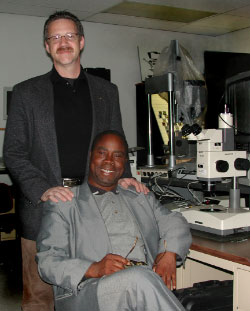 |
As I finished my junior year in high school, I watched Prosper’s
work ethic and I too thought I was destined to go to medical school.
I continued to take the required curriculum, which I hoped would get me into a good college but
for some unexplained reason, I signed up to work for the high school yearbook
as the co-editor of the sports section. It was in this role that I was
first introduced to photography by Rick Kozak (right), the school newspaper
and yearbook photographer. Rick also had a home darkroom and from that
moment, nothing was to remain the same for me and my interests. After the first time I watched Rick develop b & w film and print pictures in his home darkroom, I was smitten, and I mean smitten with the power of the picture and the process. I could not get enough of photography. Another friend of mine, let me borrow his enlarger and I used my family’s Kodak Instamatic 126 camera to take pictures. I shot Kodak 126 Verichrome pan film and I developed my film in the family bathroom using Kodak Microdol-X. It was intoxicating. At that same time I was working as a bag boy at at a local supermarket and eventually saved enough to buy my first camera, a Minolta SRT 101 camera with a 50mm lens. I took that camera everywhere and it was always loaded with Kodak Tri-X Pan film. It was my necklace. I took pictures of everything. Nothing was too ordinary or boring. Rick and I often took road trips around the Utica area photographing. I made portraits of dogs and friends. I photographed weddings and I made product pictures and everything else. I was emotionally connected to photography but my plan was remained to go to college and study pre-medicine. |
 |
|
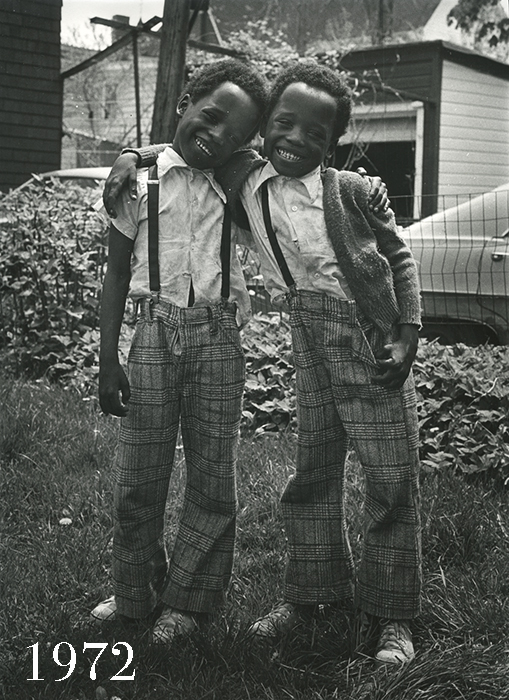 |
I had never been exposed to "applied art” in any meaningful way before this opportunity and I am not sure working on a yearbook would be considered an art form but this was first time I had experienced the process of creating something. No one in my family was an artist nor did anyone produce crafts besides knitting. I had taken one required art class in grammar school but photography was new to me. During my youthful blindness to reality, photography seemed to open doors everywhere I went. During the summer of 1973, Rick Kozak and I and set off to create a Book about Utica New York, [something we never finished]. Many of the photographs I made are still favorites. I must have shot one hundred - 36 exposure rolls of Tri-X pan film during the summers of 1973 and 1974. I also got better in the darkroom and remained the manager of the basketball team when I got to practice my photography for and of the team. I applied to and was accepted into Bradley University in Peoria Illinos in their pre-medical studies program. One of most unexpected successes beyond those mentioned was being selected for the School's Citizenship Award, which seems in some ways more important to me now than using the lens of time. |
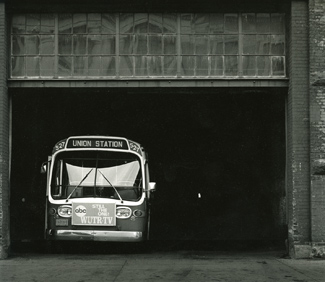 |
As I reflect on that era, I had youthful naivete' and everything seemed like magic to me. Scholastics, athletics and photography were all rolled into one seamless life that I was creating. I seemed to want adventures and prepared to attend Bradley, my Dad’s alma mater. They had a good pre-med program, they had an excellent division I basketball team and photography classes which I could take in addition to the required biology coursework. At 18, it seemed like the right thing to do not really knowing where it would take me.
|
 |
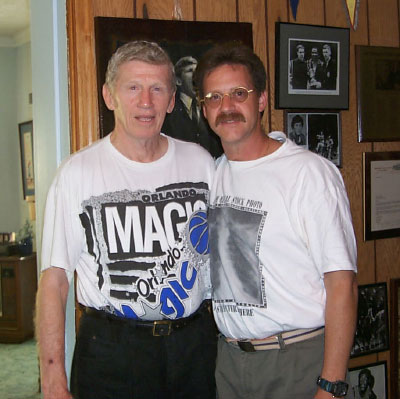 |
Harry
Erlichman, Galesville, Illinois 1999 |
Joe Stowell
in his home in front of some my pictures, 1999 |
During my second year at Bradley, I got a new job working for the Audio Visual services dept as the student photographer. I worked in this department for the remaining 3 years I was at Bradley. During each year there was a new staff photographer hired. They included Jay Boresma, Daryl Littlefield, Mike Summerville and John Kujowoa. I learned much from each of them and I loved working there. Although it mostly on the job training. That was a very practical body of knowledge that I was gaining. I developed color slides in an E-4 sinkline, I made duplicate slides using Kodak Slide Duplicating Film, I processed and printed all the department’s b&w films including 35mm and medium format. I also shot most of the University's evening events such as retirement parties, alumni activities and other non-critical events. I cleaned sinks and mixed chemistry. I made title slides using Kodak Vericolor Film and ibecame the University photo tech for all darkroom chores. The best part of the job was that I wa given a key to the department and had access to the facilities during the evenings and weekends. I cannot begin to tally the thousands of hours I spent in that darkroom during my time at Bradley. It is easy to see that it was a time of great learning how to usew materials and be a photographer. Although I amassed much photomechanical knowledge there, I also was learning the approaches required to be professional photographer. I was "paying my dues and putting in my time in with blind ambition becasue i loved nothing else as much. With each experience I learned something new and became even more curious. One of my specific recollections of the time was making 4' x 6' prints using 100 foot rolls of paper and developing the prints using sponges soaked in chemistry in a huge sink and with no trays. To my knowledge those big prints are still displayed at Bradley in the Robertson Memorial Field House.
|
|
 |
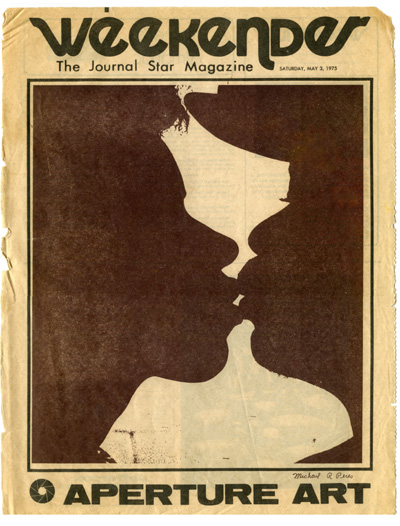 |
 |
My first published photograph Utica Observer Dispatch May 1975 |
Peoria Weekender newspaper feature cover May 1976 |
Another photograph published Peoria Journal Star - April 1977 |
I first got exposed
to biomedical photography while working on my biology degree.
As a pre-med student, I took courses in all the usual courses including biology
I, II and III, genetics, biochemistry, botany, histology, anatomy and physiology
as well as the other lab sciences and mathematics. I had fantastic professors
while at Bradley including Dr BJ Mathis and Dr Bjorklund who were incredibly
supportive of my interests in photography as a bio major. After several early humbling experiences
trying to photograph my biology experiments, I became immersed in trying to photograph
biology as I worked on my class assignments.
I took 4 photography classes including photojournalism with Howard Goldbaum and
fine art photography with Francois DeChamps. While studying ecology with Dr Mathis, I was exposed
to entomology and preparing insects for study and Dr Bjorklund exposed me
to histology and more importantly the microscope. These important professors sponsored 2 independent studies where I had my first true experiences
in photographing through a microscope and creating science photographs. |
 |
 |
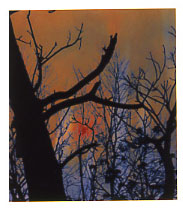 |
So i was working for the A-V Services department and the biology department, and the recycling company and then Coach Stowell invited to me to manage the Bradley University varsity basketball
team. He wanted me to be a full time tutor for the players( when necessary) and
the official team photographer. Coach Stowell loved pictures and loved giving
pictures away as gifts to benefactors of the program. For the next 3 years,
I worked a 12 month year being the team student manager performing all the various
tasks such as preparing the gym and lockers for practices and road trips, cleaning
up the locker room after practices, and other chores as delegated. Additionally,
I made pictures for the team and University and in this capacity, I also traveled
with the team and eventually visiting Madrid where we played in a Christmas 1976
tournament. |
While in Detroit, I befriended Michael Sarnacki. Michael and I were similarly dedicated to photography. Michael had founded the Michigan Friends of Photography, he ran a photo gallery in his own home and was very active in the arts. He worked a day job as a medical photographer at Oakwood Hospital and in the evenings, did his art. Michael introduced me to the who’s who in Detroit photo art community and soon I was participating in local art projects, shows and festivals. At the time I participated in a number of art festivals in Ann
Arbor, Birmingham, and Pontiac Michigan as well as the Cornhill Arts Festival
in Rochester, N.Y. In August of 1986 - I became an instructor
in the Biomedical Photographic Communications department.
Becoming a Professor
These special people would include Martin Scott who was a frequent benefactor and guest lecturer to my classes; Roger Loveland whose vast knowledge about the microscope was truly inspiring was freely shared when I was just starting out; H.L.Gibson whose help while producing a manuscript for my first chapter in a technical book established a new confidence I desperately needed; Jack Vetter’s invitation to write the Close Up and Photomacrography Chapter in the Biomedical Photography book he edited was an incredible coup in my new career; Sally Robson constant offering of encouragement, guidance and resources as my career evolved; and Leon LeBeau and Michael Coppinger who visited my photo 2 classes for more than 14 years sharing their passion for laboratory photography as well as ophthalmic photography respectively. I was in awe of John Delly and his writings and the Biological Photographic Association was also an important organization for me because of the contacts I made. It was also place where I could really practice presenting and publishing. Teaching at the Annual Rochester workshop, speaking at the annual BioComm meeting and publishing in the Journal of Biological Photography were valuable actvities in my professional development back in the late 1980's and early 1990's. Dick Norman was maybe the most helpful person of the first phase of my RIT career because he helped me fabricate imaging devices necessary to photograph my projects. |
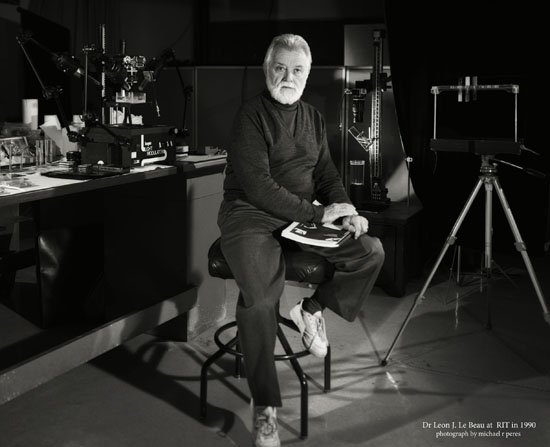 |
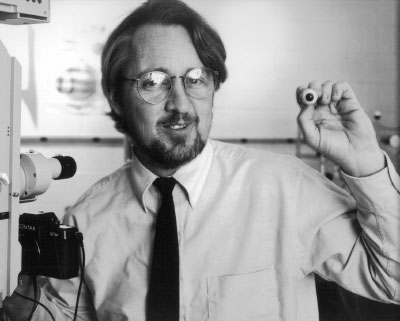 |
| Dr Leon J LeBeau @ RIT, 1991 | Michael Coppinger @ RIT 1992 |
In 1988 my son
Jonathan was born and in 1990, my daughter Leah followed. Similar to
all the important changes in my life, these 2 beautiful children have given
me perspective and helped me be directed and to be the type of father I wanted to be. There has not been one
dull moment in our house with all the various activities we have experienced
with them. Soccer, dance, floor hockey, scouts, religious school, running and
basketball are just a few of the extracurricular events beyond the normal activities
associated with their schooling. And now college has begun for them as well. It
is a great source of pride of mine to watch them and see them evolve in the next phases of their lives. During my career at R•I•T, I have completed a Master’s degree in Instructional Technology along with so many other important benchmarks. In 1989 I was appointed department chair and in 1999, I was promoted to the rank of full professor. It has been quite a ride and you can read more of my professional history in my CV if you are interested. Being professionally active has been a very important component of my career and that influences almost everything I do in the classroom. I feel being active is a core component of my job responsibility to the field and my students. I have authored numerous publications, presented many oral papers and conducted a lot of imaging related workshops in locations such as Canada, Sweden, Tanzania, Germany, the Netherlands, Autstria, the UK, AUstralia and all over the USA. I have been a member of Bio-Communications Association, formerly the BPA since 1978 and I am a member of the Ophthalmic Photographer's Society. In 1996, I was invited by Staffan Larsson and Jonas Brane to create and deliver a one-week hands-on course for PhD students in Stockholm Sweden investigating photography through the microscope. The workshop was to be modeled after the BPA workshop. This course is still running some many years later with the generous sponsorship of the Karolinksa Institute. This course helped position me professionally in a new way and provided a greater international visibility which has lead to many other new opportunities. I now also teach at Umea Institutet. In 1997, I was invited to serve as the Chair of the Lennart Nilsson Award Nominating Committee, which has been a fantasy. To work with Lennart is beyond words. The only analogy I can think that is appropriate is that I get to play along side of arguably the world’s most famous biomedical photographer. I also serve as one of the Co-Coordinators of the annual R•I•T Big Shot(www.rit.edu/cias/bigshot) project which continues to amaze me. Started in December 1987 as a way to teach Biomedical Photography students how to solve complicated probelms using simple equipment, it has become a signature RIT event. In October 2003, Big Shot photographed the Royal Swedish Palace as part of the Lennart Nilsson Conference and in April 2007 we photographed the Pile Gate in Dubrovnik, Croatia. March 2013, Big Shot focused itself on Cowboy Stadium in Dallas Texas. Visit the Big Shot page In 2001, I was interested in developing and producing an exhibition of pictures made from science along with my mentor Professor Andrew Davidhazy. This idea turned into a 4 color book and a web site that to date has had almost 100,000 visitors. This exhibition was hosted by 23 venues in 9 different countries and in 2008, Images from Science 2 was launched. In April(2003), I was selected as one of the Eisenhart outstanding faculty award recipients, an Award given for outstanding teaching at the University. Winners are chosen through a rigorous peer review. I was the co-recipient of the R•I•T 2003 Paul Gitner Award for Outstanding Achievement in the Graphic Arts for my work with Professor Davidhazy on the Images from Science project. and the journey continues. One of the most remarkable accomplishments I have had was the editor in chief of the Focal Encyclopedia of Photography - fourth edition. This project, which took 4 years to complete, was one of the most challenging and rewarding opportunities I have ever experenced on any level. In some ways the experience was like taking another degree. The years that have followed from the initial phone call I received from Bill DuBois to join the Biomed dept have become one big blur. There has not really been one dull moment and I usually cannot wait to get to campus every day. Each day is full of new adventure and my students provide an ever present opportunity to learn. I feel a huge sense of satisfaction watching the lives and careers of my former students find their way in life. I am forever grateful for the privilege to have been their teacher. They in many ways are my real heros. In all the years of being a teacher, many students have come to RIT and it would be impossible to list all of them. Many have left their mark on me in different ways. One very special person who touched my life was Mary Frantz. Mary passed away in 2003. Mary touched so many of her classmates with her passion and love of life and her smile. I will always remember her commitment to excellence and learning how to load her film reel in bed with her husband Bob while under the covers. I am sure as I approach my 30 year anniversary, this story is not finished. Updated March 2014. |